
Dango is a Japanese dumpling made with regular rice flour and glutinous rice flour. They are usually made in round shapes, and three to five pieces are served on a skewer, which is called kushi-dango (串団子). The pieces are eaten with sugar, syrup, red bean paste, and other sweeteners. Generally, dango falls under the category of wagashi, and is often served with green tea. It is eaten year-round, but the different varieties are traditionally eaten in given seasons. Dango is sometimes compared with mochi, but is different in that mochi is generally made only with glutinous rice.

Kakigōri (かき氷) is a Japanese shaved ice dessert flavored with syrup and a sweetener, often condensed milk.

Anmitsu is a wagashi that dates to the Meiji era.

Uirō, also known as uirō-mochi (外郎餅), is a traditional Japanese steamed cake made of glutinous rice flour and sugar. It is chewy, similar to mochi, and subtly sweet. Flavors include azuki bean paste, green tea (matcha), yuzu, strawberry and chestnut. Nagoya is particularly famous for its uirō, and there are other regional versions, notably in Yamaguchi and Odawara, although Odawara's uirō is better known as a medicine. It can be purchased in traditional Japanese confectionery shops throughout Japan.
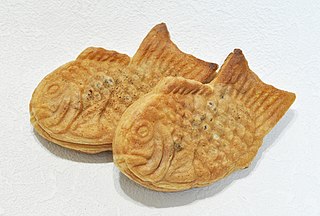
Taiyaki is a Japanese fish-shaped cake, commonly sold as street food. It imitates the shape of tai, which it is named after. The most common filling is red bean paste that is made from sweetened adzuki beans. Other common fillings may be custard, chocolate, cheese, or sweet potato. Some shops even sell taiyaki with okonomiyaki, gyoza filling, or a sausage inside. Smaller, differently shaped versions called kingyoyaki are also available and often sold in bags of five, ten, or more.
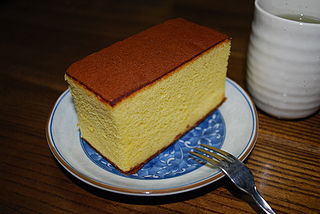
Castella is a type of Japanese sponge cake and is known for its sweet, moist brioche-style flavour and texture. It is based on cakes introduced to Japan by Portuguese merchants in the 16th century. It was then popularized in the city of Nagasaki, where it is considered a specialty. Despite its foreign origins, it is considered a kind of wagashi, or traditional Japanese confectionery.

Hanabiramochi (葩餅) is a Japanese sweet (wagashi), usually eaten at the beginning of the year. Hanabiramochi are also served at the first tea ceremony of the new year.

Wagashi is traditional Japanese confectionery, typically made using plant-based ingredients and with an emphasis on seasonality. Wagashi generally makes use of cooking methods that pre-date Western influence in Japan. It is often served with green tea.

Namagashi (生菓子) are a type of wagashi, which is a general term for traditional Japanese sweets and candies. Namagashi may contain fruit jellies, other gelatines such as Kanten, or sweetened bean paste. Namagashi is detailed, designed with using seasonal and natural motifs such as leaves and flowers to reflect the various objects of nature in Japan's four seasons. Namagashi are usually freshly made and are much more moist than other wagashi, like higashi. It generally contains 30% more water than other types. Like other wagashi, namagashi are made of natural ingredients; additives are rarely used. Namagashi is generally served with tea, and it's traditionally eaten on New Year's for good luck.

Monaka (最中) is a Japanese sweet made of azuki bean paste sandwiched between two thin crisp wafers made from mochi. The wafers can have the shape of a square, a triangle, or may be shaped like cherry blossoms, chrysanthemums, local landmarks, daruma, or other good luck symbols.

Dorayaki is a type of Japanese confection. It consists of two small pancake-like patties made from castella wrapped around a filling of sweet azuki bean paste.

Manjū is a traditional Japanese confection, usually a small, dense bun with a sweet filling. They come in many shapes and varieties.
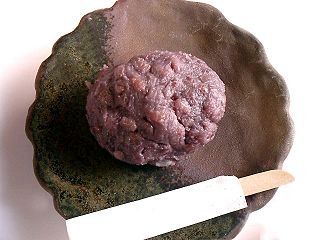
Botamochi is a wagashi made with glutinous rice, white rice, and sweet azuki paste. They are made by soaking the rice for approximately 1 hour. The rice is then cooked, and a thick azuki paste is hand-packed around pre-formed balls of rice. Botamochi is eaten as sacred food as offering during the weeks of the spring and the autumn Higan in Japan.
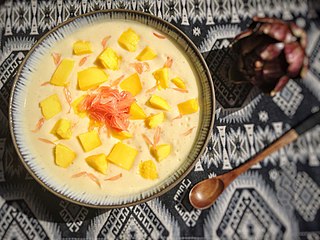
Chè is any traditional Vietnamese sweet beverage, dessert soup or stew, or pudding. Chè includes a wide variety of distinct soups or puddings. Varieties of Chè can be made with mung beans, black-eyed peas, kidney beans, tapioca, jelly, fruit, and coconut cream. Other types are made with ingredients such as salt, aloe vera, seaweed, lotus seed, sesame seed, sugar palm seeds, taro, cassava and pandan leaf extract. Some varieties, such as chè trôi nước, may also include dumplings. Chè are often prepared with one of a number of varieties of beans, tubers, and/or glutinous rice, cooked in water and sweetened with sugar. In southern Vietnam, chè are often garnished with coconut creme.

Chinese desserts are sweet foods and dishes that are served with tea, along with meals or at the end of meals in Chinese cuisine. The desserts encompass a wide variety of ingredients commonly used in East Asian cuisines such as powdered or whole glutinous rice, sweet bean pastes, and agar. Due to the many Chinese cultures and the long history of China, there are a great variety of desserts of many forms.
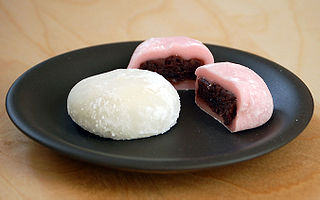
Daifukumochi (大福餅), or daifuku (大福), is a wagashi, a type of Japanese confection, consisting of a small round mochi stuffed with a sweet filling, most commonly anko, a sweetened red bean paste made from azuki beans. Daifuku is often served with green tea.

Red bean paste or red bean jam, also called adzuki bean paste or anko, is a paste made of red beans, used in East Asian cuisine. The paste is prepared by boiling the beans, then mashing or grinding them. At this stage, the paste can be sweetened or left as it is. The color of the paste is usually dark red, which comes from the husk of the beans. In Korean cuisine, the adzuki beans can also be husked prior to cooking, resulting in a white paste. It is also possible to remove the husk by sieving after cooking, but before sweetening, resulting in a red paste that is smoother and more homogeneous.


























